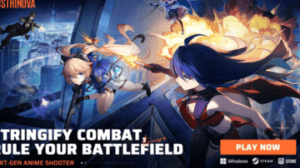Top Action Games for Competitive Players
For gamers seeking the thrill of competition, action games offer a dynamic and exhilarating experience that keeps the adrenaline pumping. These games demand quick reflexes, strategic thinking, and unparalleled skill, catering to those who thrive in high-stakes environments. From intense first-person shooters to fast-paced fighting games, the action genre provides a diverse array of challenges that test players’ limits. This article delves into the top action games that have captivated competitive players worldwide, exploring standout titles that not only promise excitement but also foster a vibrant and challenging community. Dive in to discover the best action games for those ready to prove their mettle.
Top Action Games for Competitive Players
1. Multiplayer First-Person Shooters (FPS)
Multiplayer First-Person Shooters (FPS) offer intense and fast-paced gameplay that keeps competitive players on their toes. Titles such as Call of Duty, Counter-Strike: Global Offensive, and Apex Legends are favorites in the genre, each providing different mechanics and strategic elements. In these games, quick reflexes, precision aiming, and team coordination are essential for success. Competitive modes often include ranked matches, tournaments, and regular updates with new content and challenges.
2. Battle Royale Games
Battle Royale games have taken the gaming world by storm, offering a mix of survival elements and last-man-standing gameplay. Popular titles in this category include Fortnite, PUBG, and Warzone. These games drop players into large maps where they must scavenge for weapons, resources, and fight other players to be the last person or team alive. The competitive nature of these games is heightened by limited resources, ever-shrinking play areas, and high stakes where every match is different from the last.
3. Fighting Games
Fighting games are a staple of the competitive gaming community. Series like Street Fighter, Tekken, and Super Smash Bros. offer high-skill ceilings and in-depth combat mechanics that reward practice and mastery. Competitive players often engage in intense one-on-one battles where knowledge of frame data, character matchups, and execution of complex combos can determine the victor. Many fighting games have robust competitive scenes with frequent tournaments and a dedicated player base.
4. MOBA Games (Multiplayer Online Battle Arenas)
MOBA games, such as League of Legends and Dota 2, are highly strategic and involve team-based gameplay where players control unique characters with special abilities. Each match requires coordination, strategy, and the ability to adapt to ever-changing situations. Competitive players must excel in roles like laning, jungling, and team fighting. The deep strategic elements and high skill requirements make MOBAs some of the most challenging and rewarding games for competitive players.
5. Tactical Shooters
Tactical shooters focus on realistic gameplay, teamwork, and strategy. Titles like Rainbow Six Siege and Valorant offer a blend of precise shooting mechanics and strategic gameplay elements such as planning, utility usage, and map control. These games often feature a heavy emphasis on communication and coordination, where understanding the game’s mechanics and strategizing with your team is key to outsmarting opponents. The competitive scene is strong, with regular updates and a dedicated community.
| Game Genre | Popular Titles | Key Elements |
|---|---|---|
| First-Person Shooters (FPS) | Call of Duty, Counter-Strike: Global Offensive, Apex Legends | Quick reflexes, precision aiming, team coordination |
| Battle Royale | Fortnite, PUBG, Warzone | Survival, resource scavenging, last-man-standing |
| Fighting Games | Street Fighter, Tekken, Super Smash Bros. | Combat mechanics, frame data, character matchups |
| MOBA (Multiplayer Online Battle Arenas) | League of Legends, Dota 2 | Team-based strategy, character abilities, roles |
| Tactical Shooters | Rainbow Six Siege, Valorant | Realistic gameplay, teamwork, strategy |
FAQs
What makes an action game ideal for competitive players?
An action game ideal for competitive players often features intense gameplay that requires quick reflexes, strategic thinking, and situational awareness. Strong mechanics and balanced gameplay are crucial, allowing players to rely on skill rather than luck. Multiplayer modes or ranking systems typically add an element of competition, enabling players to strive for the top. Additionally, regular updates and content additions keep the game fresh, preventing the competitive scene from stagnating.
Which action games are currently popular in the competitive gaming scene?
Several action games stand out in the competitive gaming scene due to their robust competitive features and strong player communities. Titles like Apex Legends, Call of Duty: Warzone, Fortnite, and Valorant are among the top games that attract competitive players. These games offer engaging gameplay, regular updates, and active support from developers, which keeps the competitive scene thriving. Each game has its own unique mechanics and style, appealing to different types of action game enthusiasts.
How do developers balance action games to ensure fair competition?
Developers balance action games by continuously monitoring gameplay data and player feedback. Regular patches and updates are crucial to tweak game mechanics, address bugs, and adjust character or weapon attributes. A balanced game ensures that no single element becomes overwhelmingly powerful, maintaining fair competition. Beta testing, public test realms, and community involvement help developers make informed adjustments, leading to a more equitable gaming experience for all.
What are the most important skills for succeeding in competitive action games?
Success in competitive action games hinges on several key skills. Reflexes and hand-eye coordination are essential for executing actions quickly and accurately. Strategic thinking and map knowledge allow players to anticipate enemy movements and plan their actions effectively. Team communication is also vital, especially in multiplayer games, to coordinate strategies and achieve objectives. Lastly, adaptability enables players to adjust their tactics in response to changing game dynamics and opponent strategies.




























Post Comment